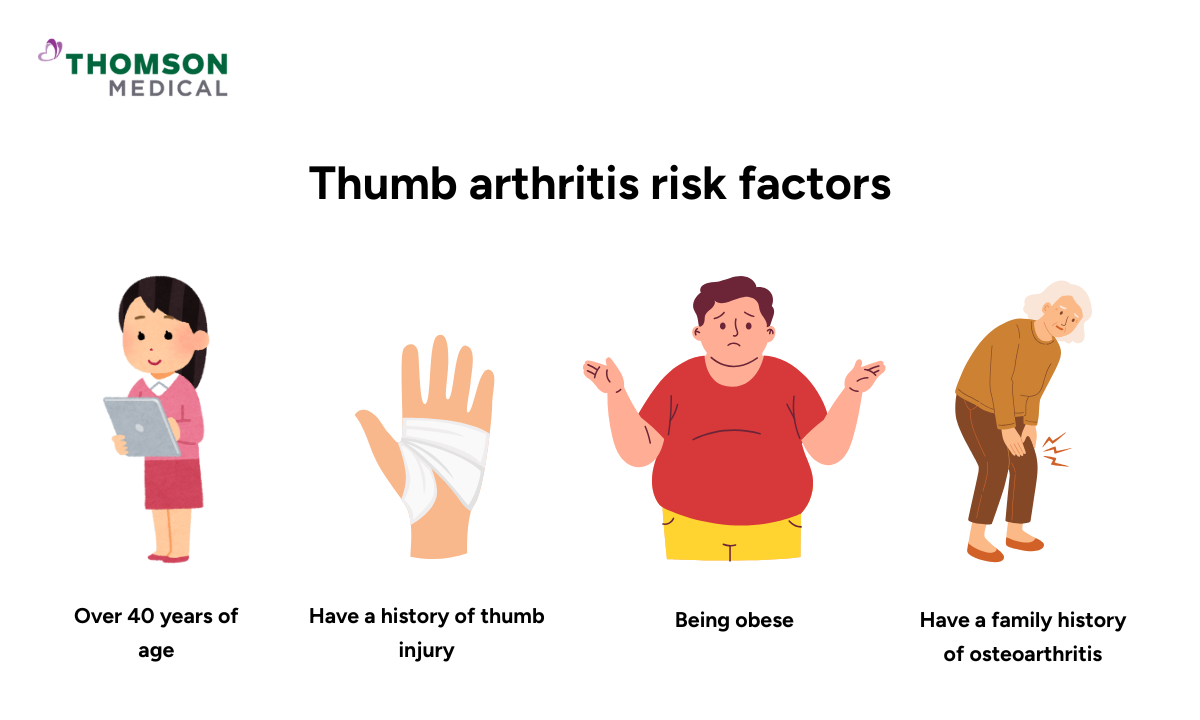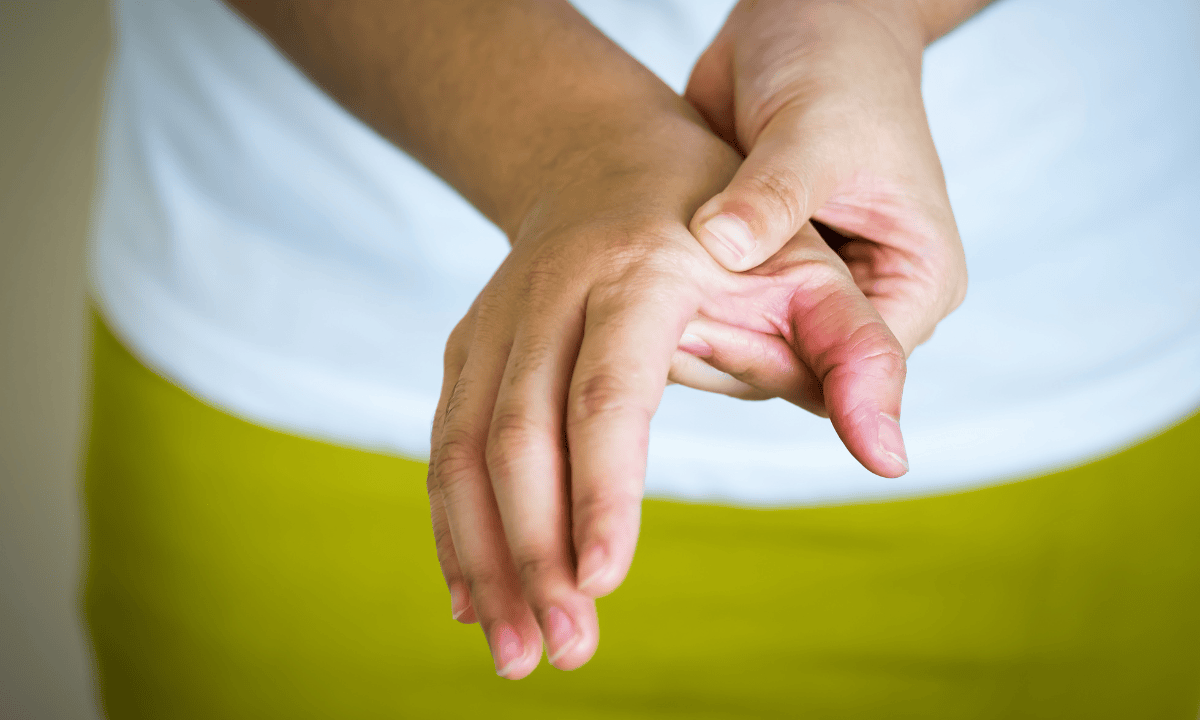What is thumb arthritis?
Thumb arthritis, also known as basal thumb arthritis or carpometacarpal (CMC) arthritis, is a common type of osteoarthritis that affects the joint at the base of the thumb. It occurs when the protective cartilage that cushions the joint gradually wears away, causing the bones to rub against each other and resulting in pain and stiffness.
Your healthcare provider can perform a thumb arthritis test to confirm this condition. The test usually involves a physical examination to assess thumb movement and tenderness, followed by imaging tests such as X-rays to evaluate the extent of joint damage. Early testing enables timely treatment to manage symptoms and prevent progression.
Common thumb arthritis symptoms
In a healthy thumb joint (basal joint), smooth cartilage covers the ends of the thumb and wrist bones, enabling free movement and allowing you to grip or pinch objects easily. However, this cartilage gradually wears away due to ageing (osteoarthritis), causing the bones to rub directly against each other.
This friction can lead to joint damage and various symptoms. Common symptoms of thumb arthritis include:
Pain at the basal joint, especially during activities that involve gripping or pinching
Swelling, stiffness, and tenderness at the base of your thumb
Loss of strength when pinching or grasping objects
Decreased range of motion in your thumb
Visible deformity at the base of the thumb, sometimes appearing as a bony bump
A gritty feeling or grinding sound when moving your thumb, due to roughened joint surfaces
Risk factors

In addition to these symptoms, several risk factors can increase the likelihood of developing thumb joint arthritis, such as:
People over 40 years old
Women, particularly after menopause, due to hormonal changes and differences in joint structure
Individuals with a history of thumb or joint injuries
Those who perform repetitive thumb movements, including manual labourers, musicians and crafters
People who are obese
- Individuals with certain health conditions, such as lupus or rheumatoid arthritis
Those with a family history of osteoarthritis
If you are experiencing persistent pain, swelling, or difficulty using your thumb, it's recommended that you seek medical attention as soon as possible. This is because thumb arthritis is treatable, and an early intervention can mitigate discomfort and delay its progression.
Request an appointment with Thomson Medical for further assessment and diagnosis. Our specialists can assist in evaluating your condition, which may involve a thumb arthritis test to determine whether your discomfort is due to arthritis.
What to expect during the thumb arthritis test?
To diagnose thumb arthritis, your healthcare provider will start by assessing your symptoms. They will ask you about the persistence of your thumb pain, whether specific activities are causing your discomfort, and if you have had any previous thumb injuries.
They will then conduct a physical examination to check for tenderness, swelling, and a limited range of motion by closely inspecting your hand and thumb joints. They may also assess your grip strength and observe how your thumb moves.
Specific diagnostic manoeuvres
In addition, your healthcare provider may perform some specific physical tests to confirm a diagnosis of thumb arthritis, including:
Thumb grind test
A thumb grind test is one of the most commonly used diagnostic physical tests for thumb arthritis. Your healthcare provider will start the test by applying gentle pressure while rotating the thumb joint.
If this movement causes pain or a grinding sensation, it may indicate thumb joint arthritis.
Traction-shift test
This newer diagnostic technique involves gently pulling and shifting the thumb joint.
- If this manoeuvre causes pain, it may indicate subluxations (partial dislocations) and arthritis.
Pinch test
In this test, your healthcare provider will ask you to make an "O" shape with your thumb and index finger.
If you have difficulty forming a proper “O” shape with your hand, which instead resembles a “D” form, or if you experience pain while doing so, it may be a sign of thumb arthritis.
Lever test (pressure-shear test)
During the lever test, your doctor will hold your first metacarpal bone, just after your thumb joint, and rock your thumb back and forth to apply pressure to your anterior oblique ligament.
If you experience pain at the base of the thumb, this is considered a positive result. Studies have shown that the lever test is effective in detecting thumb arthritis and may be more reliable than the grind test.
Metacarpal flexion and extension tests
In these tests, your doctor will ask you to flex or extend your thumb while attempting to resist the movement. Pain during either movement may indicate arthritis in the joint.
Pinch strength test
A pinch dynamometer can be used to measure your pinch strength. This device evaluates your ability to perform different types of pinches (lateral, three-point, and two-point).
Early stages of thumb arthritis often show reduced pinch strength in the affected hand compared to the unaffected hand.

Medical imaging
After completing the physical examination, your healthcare provider may order an X-ray to confirm the diagnosis of thumb arthritis and assess the extent of joint damage. Here's what an X-ray may show:
Joint space narrowing, which is a sign that cartilage has worn down between the bones at the base of the thumb
Bone spurs, which are extra bony growths that form around the joint in response to the loss of cartilage
Cartilage loss, which is a reduction in the space between the bones that can eventually result in bone-on-bone contact
Understanding X-ray results
After the X-ray test results are out, here's what the results mean:
Normal results:
The joint appears healthy, with normal spacing between the bones, and there are no signs of bone spurs or cartilage loss.
Mild arthritis (stages 1–2):
There may be slight narrowing of the joint space and minimal formation of bone spurs.
Symptoms are typically mild, with occasional discomfort.
Moderate to severe arthritis (stages 3–4):
X-rays show significant joint space narrowing and prominent bone spurs, with possible joint deformity or subluxation (partial dislocation).
These findings are usually associated with persistent pain, stiffness and a limited range of motion in the thumb.
A thorough assessment of thumb arthritis involves reviewing symptoms, conducting a physical examination and carrying out specific diagnostic manoeuvres and medical imaging. These tests help your healthcare provider diagnose the condition and decide on the most appropriate treatment plan.
Treatment options
The treatment for thumb arthritis depends on how severe the condition is. For the early stages of thumb arthritis, a combination of non-surgical treatments is usually effective. However, if the condition is more serious, surgery may be necessary.
Early-stage treatment
If your thumb arthritis is mild, your doctor may recommend the following conservative approaches:
Lifestyle adjustments:
Avoid activities that involve repetitive gripping, pinching, or twisting motions that can strain the thumb joint.
Medication:
To help relieve pain and reduce inflammation, your doctor may prescribe non-steroidal anti-inflammatory drugs (NSAIDs), such as paracetamol or ibuprofen.
They may also prescribe topical medications that are applied to the skin over the joint, such as diclofenac.
Thumb splints:
To support and stabilise the thumb joint, it might be recommended that you wear a splint from time to time, both during the day and at night.
Physical therapy:
You might be recommended physical therapy to strengthen the muscles around your thumbs, improve joint stability, and maintain range of motion.
Advanced-stage treatment
However, if the arthritis is more severe or conservative measures are no longer effective, your healthcare provider may consider additional options, which include:
Corticosteroid injections:
If medication and splinting don't provide enough relief, your doctor may recommend a corticosteroid injection directly into the thumb joint to reduce inflammation and pain.
These can provide temporary relief, but repeated use is usually limited due to potential side effects.
However, if the pain persists and significantly limits your daily activities, your doctor may recommend surgical procedures. Surgical options include:
Joint fusion (arthrodesis):
The bones of the joint are fused together to stabilise the thumb and relieve pain, but this procedure also limits the movement of the joint.
Joint replacement (arthroplasty):
The damaged joint surfaces are replaced with artificial implants or tissue grafts to relieve pain while preserving some thumb movement.
Not sure which arthritis treatment options may be right for you? Request an appointment with Thomson Medical to consult our specialist, who can guide you throughout treatment and create a tailored care plan for you.
FAQ
What are the first signs of arthritis in the thumb?
The earliest signs typically include pain at the base of the thumb, especially when pinching, gripping, opening jars, or turning keys.
You may also notice swelling, tenderness, stiffness, and reduced strength or range of motion in the thumb.
How do you test for arthritis in your thumb?
A diagnosis of thumb arthritis usually includes a combination of a physical examination and medical imaging.
Physical tests include:
The grind test, where the doctor applies pressure and rotates your thumb to reproduce pain.
The lever test involves rocking the base of your thumb to see if it causes discomfort.
The pinch test involves touching your thumb to the tip of the index finger to assess pain or difficulty.
Medical imaging:
An X-ray may be ordered to confirm the diagnosis and assess the extent of joint damage, such as joint space narrowing or bone spurs.
Can thumb arthritis go away?
No, thumb arthritis is a chronic and progressive condition. While it cannot be reversed, symptoms can often be managed effectively with treatment and lifestyle adjustments.
Is massage helpful for thumb arthritis?
Yes, a gentle massage using your hands or thumbs can help to relieve pain, improve blood flow, and reduce stiffness.
However, remember that applying excessive force during a massage may worsen symptoms.
What is the best exercise for thumb arthritis?
The best exercises for thumb arthritis include:
Thumb stretches, where you gently pull your thumb back and forth.
Thumb opposition exercises, where you touch the tip of your thumb to each fingertip.
Grip-strengthening exercises, such as squeezing a soft ball or putty to build strength.
Flexion and extension exercise, where you will bend and straighten your thumb in the palm and keep it away from the hand.
At what age does arthritis start?
Thumb arthritis most commonly develops after the age of 40 and is more prevalent in women, particularly after menopause. Risk increases with age, repetitive thumb use, and joint injuries.
The information provided is intended for general guidance only and should not be considered medical advice. For personalised recommendations and tailored advice, please consult a specialist at Thomson Medical. Request an appointment with Thomson Medical today.
For more information, contact us:
Thomson Specialists (Thomson Medical Centre) — Orthopaedic
Request an Appointment